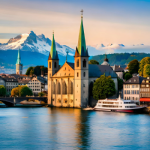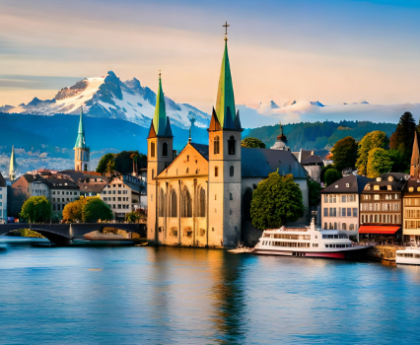:max_bytes(150000):strip_icc()/garden-of-the-gods-colorado-COROADTRIP0420-8eb0edc6b1404c518e949f12c11b5362.jpg)
To experience the best of the U.S. via the great open road, look to Colorado. This picturesque state straddling the Rocky Mountains is home to some of the most astounding stretches of highway in the country, connecting mountain resorts and artists’ colonies to pioneer towns. In short, it’s the perfect place for the ultimate road trip. With that in mind, we’ve devised a route that hits plenty of spots that make the Centennial State so special.
Our itinerary takes you through three spectacular national parks: Rocky Mountain, Mesa Verde, and Great Sand Dunes. While the last one doesn’t require an admission fee, the first two do ($30 per car, including entry for all passengers, for one day or $35 per car for seven days of access). As of May 24, 2024, you must reserve a timed pass to enter Rocky Mountain National Park. If you’re interested in purchasing an America the Beautiful annual pass, which gets you into all U.S. national parks and federal recreational lands, check each park’s website below for more information about discounts for seniors, military members, and those with permanent disabilities.
Without further ado, here’s our handy guide to everything you should do on a Colorado road trip.
Denver
iStockphoto / Getty Images
Colorado’s capital and biggest city is inevitably where any road trip should start. Not only is Denver home to the state’s largest and busiest airport, and therefore where most travelers arrive, it also acts as a gateway from the plains in the east into the Rocky Mountains. There’s plenty to do here before you start your journey: Grab some green chiles at El Taco de Mexico, explore historic Larimer Square, go to one of the city’s great museums — the Denver Art Museum and Denver Museum of Nature & Science are great places to start — and perhaps buy yourself a pair of cowboy boots. Whatever you do, make sure your last activity is getting in your car and driving northwest.
Boulder
Denver’s smaller, more free-spirited sibling Boulder is home to the University of Colorado’s main campus, which means you can expect a whole lot of restaurants and businesses catering to college students. You’ll also find some sublime hiking on and around the Flatirons, an iconic formation formed by dramatic, diagonally tilted slabs of rock.
Estes Park
Tanya Nikolic / Travel + Leisure
Your journey northwest continues to Estes Park, the first destination on this route wholly within the Rocky Mountains. This quaint town has become a popular tourist stop, due to its proximity to some of the region’s best rock climbing and mountain trails. Estes Park is also considered the jumping-off point for much of Rocky Mountain National Park, where you can easily spend several days exploring backwoods trails, finding waterfalls, and spotting wildlife. This part of the itinerary is optional, but definitely encouraged if you have the time.
Trail Ridge Road
If you’re road-tripping between May and October, you’re in luck. The next portion of the route contains what is considered to be one of the most beautiful drives in America: Trail Ridge Road, a switchback-saturated stretch of U.S. Highway 34 that crosses over the Continental Divide and is closed during the fall and winter. In the spring and summer, you can pass through some of the region’s highest mountains. Witness the sun glinting off glaciers as you weave through dramatic passes and drive along impossibly blue ponds until you reach Grand Lake. Refuel, then it’s onto the next oasis.
Glenwood Springs
The aptly named Glenwood Springs is the hot spring capital of the area, with huge natural hot springs bubbling up from the earth. It’s just what you want to see after a long drive from Grand Lake, and a particularly scenic remedy for driving-related cramps. The town is located right where the Colorado and Roaring Fork Rivers meet, in a valley cradled by steep mountain faces.
Telluride and Ouray
Gallo Images / Getty Images
Drive a few hours from Glenwood Springs and you’ll enter gold rush territory. Sure, you can try panning in the Uncompahgre or San Miguel Rivers — it’s a good way to cool off, but maybe not to get rich — though the real draw in Telluride and Ouray is the history. These little mountain villages are chock-full of relics from the area’s Wild West days, from museums like the Ouray Alchemist Pharmacy Museum to mining tours in Telluride. They’re also both tucked away in furtive, but gorgeous, canyons. You can hit Telluride, which is larger, more bustling, and artsier (it’s also home to the Telluride Film Festival), or Ouray, which is smaller and more rustic. Either way, we’re venturing south.
Mesa Verde National Park
Continuing south, you’ll trade the gold rush era for more ancient times at Mesa Verde National Park. These lands in Montezuma County were once inhabited by the cliff-dwelling ancestors of the Pueblo people, who constructed homes out of the sandstone from the cliffs and mesas on which they were built. The result is extraordinarily dramatic and incredibly enlightening. While there are hundreds of these sites throughout the park, the most impressive is Cliff Palace, pictured above, which lies in the shadow of a magnificent rock arch. Check out its elaborate rooms and the decorative plasters, all of which have withstood erosion and time.
Durango
Michael Snell / Robert Harding World Imagery / Getty Images
Beginning our turn east, Durango is the first major town on the map after leaving Mesa Verde. It’s a great place to stop and rest for a while, combining the laid-back charm of small-town America with a rich history rooted in its importance as a railroad hub. It has also served as the backdrop in many Hollywood Western films, and you can visit several shooting locations from “Butch Cassidy and the Sundance Kid.”
Great Sand Dunes National Park
Visuals Unlimited / Getty Images
Drive three hours down Route 160 and you’ll arrive in a place that feels so otherworldly, you’ll feel like you’re on another planet. Great Sand Dunes National Park and Preserve seems totally incongruous with the landscape around it, but that’s what makes it so enticing — towering, ivory-colored dunes up to 750 feet tall are an echo of the nearby mountains. Camping here is the move, as the effect of the clear night sky over the dunes is a popular astronomical phenomenon that must be seen to be believed.
Cañon City
iStockphoto / Getty Images
There’s no better place in Colorado to witness the awe-inspiring force of water than Cañon City, so named for the steep cliffs carved by the Arkansas River. Whether you’re looking for a gentle, comfortable sightseeing experience like the Royal Gorge Route Railroad or a more extreme method like rafting, you’ll find it here, in addition to plenty of wineries and restaurants where you can luxuriate after feasting your eyes.
Colorado Springs
iStockphoto / Getty Images
Colorado Springs is the last stop on your vehicular journey, and it’s a bit of a doozy. Not only is this the second-largest city in the state, it’s also a stone’s throw from two of Colorado’s most impressive natural landmarks: Pikes Peak and Garden of the Gods. The first can be easily ascended by car via Pikes Peak Highway, and the views from its 14,115-foot summit are truly magnificent — they actually inspired Katharine Lee Bates to write “America the Beautiful.” The second, Garden of the Gods, is a gorgeous public park that combines strikingly red rocks with lush forest scenery.
After indulging in your outdoor activity of choice, end your trip with green chiles at King’s Chef Diner and bask in the success of a road trip well spent. If you’re returning to Denver to fly home, it’s just an hour’s drive or so north to reach the airport.
This post was originally published on 3rd party site mentioned in the title of this site









